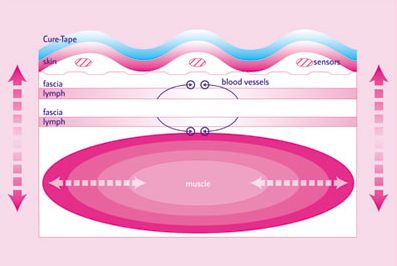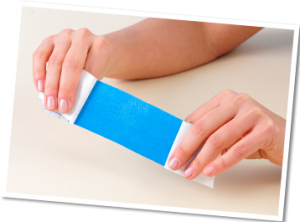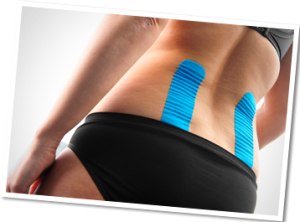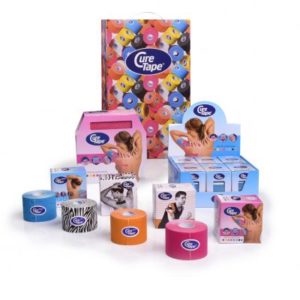Looking for information about kinesiology tape (also known as kinesiotape or elastic therapeutic tape)? THYSOL is an authority in the field of kinesiology taping and wants to share that knowledge with you. Learn more about kinesiology taping by attending one of our MTC® kinesiology taping courses or contacting us on 0411129759.
Quicklinks:
How to compare kinesiology tape?
Looking for kinesiotape, but you do not know where to start researching? The most important factor is vaue for money. THYSOL USA is manufacturer and reseller of CureTape®. CureTape® Europe’s number one kinesiotape for Professionals and is being produced in our own factory and that is why THYSOL Australia can offer kinesiology tape at wholesale prices and at the same time guarantee the high quality of our product CureTape®.

Elastic therapeutic tape was developed in the 1970s in Japan. The method originated from the principles of the ‘Kinematics’ known under the English term ‘Kinesiology’. Kinesiology as a form of therapy utilises muscle testing in order determine where the muscle ROM (Range of Motion) or balance is disturbed in the body and how to restore the muscle balance back to normal function. Created in Japan this therapy was later practiced and expanded upon in Korea. It was discovered that by making use of elastic tape by the kinesiologist’s, a faster recovery of the muscle balance was achieved.
How does kinesiology tape work?
Prior to applying kinesiology tape the muscles and joints are positioned in a stretched position, and then the tape is affixed to the skin, allowing a full range of motion. When the body comes back into a relaxed position, the tape lifts the skin slightly. Beneath the tape small corregations can be seen called ‘convolutions’.
Convolutions create space between the epidermis and dermis (Interstitial space) where many kinds of receptors, nerves, blood and lymph vessels are located. In the upper layer of the skin (the superficial fascia) 85% of the pain sensors are located. By taping this way the pain dampening or analgesic affect is activated. Pain is alleviated or disappears completely allowing the patient to move more freely restoring normal muscle function. Results are immediately noticeable during this form of treatment by the therapist.

How to apply & use kinesiology tape
Kinesiology tape can be used for many and various injuries and complaints. It accelerates the self-healing ability of the body, provides support, stability and allows full ROM. The kinesioly taping now forms part of a ‘Gold Standard’ treatment of any related health care professional. Kinesiotape can be used throughout the entire healing process.
Kinesiotape can be used for various applications. It is very important for Physiotherapists, other health professionals and their patients, to have access to information regarding kinesiology taping. Below you will find articles that have direct application to your practice.
★★★★★
“I am using CureTape, a kinesiology tape that convinced me from the beginning because my clients tolerate it on the skin until it comes off by itself, even up to 2 weeks. CureTape is easy to take off and also easy to apply for those who feel confident to use it at home. I haven’t seen any skin irritation, not even complaints about an uncomfortable feeling. The general response of my customers is very positive, they feel the support of the kinesiotape for muscles and joints and the release of tension and pain.”

– Martina Link, Balance Your Life clinic
Kinesiology tape colours range
Kinesiotape is available in various colours. THYSOL offers CureTape® in up to 9 different colours; Beige, Blue, Yellow, Green, Orange, Red, Pink, White and Black.
Additionally, there are also various kinesiology tape with designs available through our CureTape® Art product range.
Extensive range of sizes of kinesiology tape
THYSOL also offer a range of different sizes of tape. Kinesiotape in general comes in rolls 5 meters long and 5 cm in width. Additionally, THYSOL also offers bulk rolls (CureTape® Giant) of 31.5 meters long and CureTape® Classic available in widths: 1, 2, 5 or 7.5 cm.
Kinesiotape: Tips for taping

- Always make sure to be stuck to the skin is clean, dry and free of grease.
- It is always advisable to stick the kinesiotape on the “bare skin”. A hairy skin sticky tape less and late (so) quicker release. Since the kinesiotape must be removed, it is recommended to remove the hair. Razor blades are thereby not recommended since there earlier wounds can be caused by shaving.
- The achievement of the paper tape is easiest if one cut piece of tape with the cotton side keeps to itself and the finger is on the upper side.
- It is also possible to tear the paper first (in a number of techniques, it is recommended that even this emphatically.
- The base and the armature of the kinesiotape are always applied without stretching.
- Base and anchors the kinesiotape will always be clipped around the tape thus remains better and longer.
- Avoid folds in the tape or in the skin under the tape, in areas with folds easily cause blisters.
- If the kinesiotape was built, light and prolonged rubbing warm for optimal adhesion.
- The kinesiology tape adheres better if the material is warmer, therefore be careful application of heat to areas of skin with tape (for example, do not blow dry).
- Sometimes there is short-term (10 to 20 minutes) itching under the tape. This is no problem. Itching or irritation that lasts longer than half an hour, the kinesiology tape must be removed.
- The kinesiology tape must be removed carefully. Easy is it for example to do under the shower by the application making quite wet, tightening the skin and tape from top to bottom of the skin roll down and compromising the skin with the fingers on rack.
 The best way to remove the tape is painlessly through the use of an oil (baby oil). Oil acrylic adhesive dissolves. It is also possible to sprinkle the tape-application with Sterilium whereby the adhesive layer also dissolves.
The best way to remove the tape is painlessly through the use of an oil (baby oil). Oil acrylic adhesive dissolves. It is also possible to sprinkle the tape-application with Sterilium whereby the adhesive layer also dissolves. - There can cause skin irritation and blisters occur when the kinesiotape is removed careless mistake, but also by application of the tape. Too much strain can cause irritation and blisters.
- To get as many “convolutions” (visible ripples on the kinesiology tape by the lifting effect of the skin), you can bring out the best skin to stretch and apply the tape with minimal strain.
- The therapeutic tape can be used only in the length. If smaller tapes are required, (e.g. for children), the width of the tape need to be trimmed.
- By treating the skin before taping with 3M Cavilon Barrier Film spray can prevent possible skin irritation. the adhesive strength of the tape also increases so that the kinesiotape can be worn for longer. It is always advisable to tape to the skin to be treated with this spray.
Kinesiology taping courses
With its own team of teachers, THYSOL has developed and run 15,000 MTC® kinesiology taping courses world-wide to date. These are known and offered through the MTC® (Medical Taping Concept) brand.


THYSOL authority in kinesiology taping
As one of the foundation companies THYSOL introduced kinesiology taping to the medical market in Europe. CureTape® is produced in our own factory in Korea and meets the highest quality standards. CureTape® is registered as a Class 1 medical product and is annually tested by TUV Rhineland.
Medical Taping has proven its critical role in healing in physiotherapy practices accross Europe. A study in 2014 concluded that 71% percent of the Physiotherapy practices in the Netherlands use kinesiology taping. Kinesiology taping is second only to general Physiotherapy which is the most commonly used therapy among healing modalities.
Where to buy kinesiology tape in the US?
THYSOL now supplies and distributes CureTape® in the US. Since 1998 CureTape® is has been produced in our own factory in South Korea. Because we manage the production process itself in our own facilities, we can guarantee the highest quality end product to our customers.
Effectiveness of CureTape® kinesiotape
- High product quality
- No additional medications used in manufacture
- Elastic cotton tape with a stretchability of 130 to 140% (attributes similar to the human skin)
- Air and water permeable but resistant to water (showering, swimming)
- 100% hypoallergenic acrylic adhesive layer, arranged according to a wave pattern and activated under the influence of body heat
- CureTape® can adheres for several days
- Taping is active treating patients 24 hours a day
Physiotherapists, health clinics and other health professionals often ask, if they can test CureTape®. THYSOL USA understands that switching brands of kinesiology tape is not a daily matter. Therefore THYSOL USA has developed a CureTape® sample pack for you to make a well-informed business decision.
FAQ Kinesiology tape
Kinesiology Tape has an elasticity that corresponds to the elasticity of the skin. When the tape is applied correctly, the muscles and joints are first stretched as far as possible, after which the tape is applied. The Kinesiology Tape lifts the skin slightly as soon as the skin returns to its natural relaxed position. Waves, which are also called convolutions, form at the place where the tape is applied. The convolutions create a space between the epidermis and the subcutis, where all kinds of nerve receptors, blood and lymph vessels are located. The pressure around this area is thus reduced thanks to the application of the Kinesiology Tape. At the same time, the circulation of blood and lymph is stimulated.
Kinesiology taping is applied in a very wide and varied way. Kinesiology tape is applied as an extra intervention, as part of treatment, to achieve a faster result. Because the tape can remain in place for several days, you create a 24-hour treatment.
By combining various taping techniques, problems can be treated on several levels simultaneously. The most common problems where Kinesiology Tape is applied are:
- Reduction of pain
- Reduction of swelling
- Supportive movement pattern
- Reduction of allergic symptoms (e.g. hay fever)
- Improvement of blood circulation
The material of the kinesiology tape is made of high-quality cotton and has a similar elasticity to human skin (130-140% stretch). The hypoallergenic acrylic adhesive layer on the back of the tape reduces the risk of skin irritations. The adhesion of this adhesive layer is activated by your body heat. The tape has an air and water-permeable fabric structure. This tissue structure is water-resistant and can be worn for several days without the tape losing its effectiveness.
In short, kinesiology tape is:
- The most commonly used tape among professionals
- Constant, high quality
- Skin-friendly and suitable for sensitive skin
- Latex-free, elastic, water resistant, and breathable
- Production in our ISO-certified factory in South Korea
- Complies with the latest European medical MDR legislation
- Excellent quality, TÜV and, ISO certificate
Elastic Kinesiology Tape is often used by physiotherapists, sports masseurs and physiotherapists. But even injured sportsmen and women sometimes use the tape themselves. The kinesiology tape provides optimal stimulation and stabilization of joints and muscles.
It is always important to start by washing your hands before applying the tape. Kinesiology Tape adheres best to grease-free, and dry skin. When there is a lot of hair at the place of application, the tape has less or no effect. Therefore, it is advisable to remove the hair.
When cutting the tape to size, it is important to take into account the amount of stretching you want to apply. It is also advisable to cut the corners off. In this way, the chance of the corners coming loose is smaller. Tear up the paper and make sure that the anchors are still covered with the paper after applying the tape. The anchors are applied without stretching. Make sure that you avoid folds when applying the tape. To prevent blisters or irritation, it is important not to use too much stretch when applying the tape.
To learn more about applying the tape yourself, we recommend using our book The Ultimate Kinesiology Taping Guide!
- Acute injury, which cannot be properly/completely diagnosed
- Fever
- Pregnancy (first 3 months) in the pelvic region
- An allergic reaction to the skin
- Thrombosis, a thrombus could come loose
- An open wound, burns, skin disorders (except dry skin), fresh/not closed scar
- Oedema (fluid accumulation) caused by heart or kidney problems, circulation should not be increased
- In the presence of carcinoma or metastasis, circulation must not be increased
CureTape Classic
- Beige
- Black
- Blue
- Green
- Pink
- Orange
- Yellow
- Red
CureTape Sports
- Pink
- Black
- Beige
- Lime
- Blue
- Orange
CureTape Giant
- Beige
- Black
- Blue
- Green
- Pink
- Orange
- Yellow
- Red
CureTape ART
- Tattoo
- Leopard
- Tiger
- Zebra
- Army Blue
- Tartan
CureTape Punch
- Beige
- Black
- Blue
- Pink






